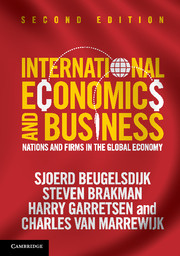Book contents
- Frontmatter
- Contents
- List of figures
- List of tables
- List of boxes
- Preface
- Part I Introduction
- Part II Firms, trade, and location
- Part III Capital, currency, and crises
- 8 Exchange rates
- 9 Currency crises and exchange rate policy
- 10 Gains from international capital mobility
- 11 Financial crises, firms, and the open economy
- 12 The Great Recession
- Part IV Consequences of globalization
- Bibliography
- Author index
- Subject index
9 - Currency crises and exchange rate policy
from Part III - Capital, currency, and crises
- Frontmatter
- Contents
- List of figures
- List of tables
- List of boxes
- Preface
- Part I Introduction
- Part II Firms, trade, and location
- Part III Capital, currency, and crises
- 8 Exchange rates
- 9 Currency crises and exchange rate policy
- 10 Gains from international capital mobility
- 11 Financial crises, firms, and the open economy
- 12 The Great Recession
- Part IV Consequences of globalization
- Bibliography
- Author index
- Subject index
Summary
Keywords
Exchange rates • Currency crises • First-generation currency crisis models • Second-generation currency crisis models • Efficiency of financial markets • Contagion of currency crises • Crisis frequency • Policy trilemma • Policy dilemma
Introduction
In Chapter 8 we focused on the basics of the economics of exchange rates. Understanding the basics of exchange rates is not only important from the perspective of international economics but also from the perspective of international business. When firms trade with or invest in different countries, they are confronted with the fact that their transactions are in multiple currencies. We analysed in Chapter 8 how firms deal with this fact and the associated exchange rate risk. Part III of our book focuses on international capital mobility. International capital flows by their very nature lead to supply of and demand for currencies and can have implications for exchange rates. In this chapter we turn to a major issue affecting internationalizing firms directly, namely sudden exchange rate movements that are serious enough to speak of a currency crisis. We deal with the question of how in a world of international capital mobility the (fixed) exchange rate may ‘suddenly’ cease to exist. This is directly linked to our analysis of exchange rates and international capital mobility in the previous chapter. After our discussion of the characteristics of currency crises, we discuss what policy-makers can do to prevent these from happening. We show that policy-makers are facing a trilemma. In analysing currency crises, Chapter 9 is about the potential drawbacks of international capital mobility for firms and the economy as a whole via the exchange rate channel. Chapter 10 discusses the main gains from international capital mobility. Chapters 11 and 12 will subsequently combine the previous analyses by showing how international capital mobility and exchange rate movements can play a role in financial crisis, like the global crisis that occurred in the aftermath of the Lehman Brothers bankruptcy in September 2008. The analysis of currency crises in this chapter thus serves as an important input for our explanation of financial crises in Chapters 11 and 12. We shall argue there that in an open economy with international capital mobility, a currency crisis and the change in capital flows that come with such a crisis are the crucial links between a domestic financial crisis and the global economy.
- Type
- Chapter
- Information
- International Economics and BusinessNations and Firms in the Global Economy, pp. 256 - 281Publisher: Cambridge University PressPrint publication year: 2013

